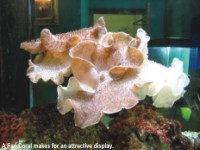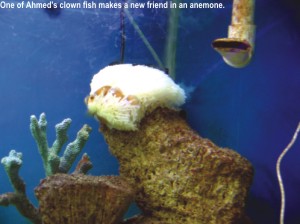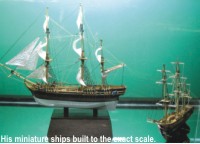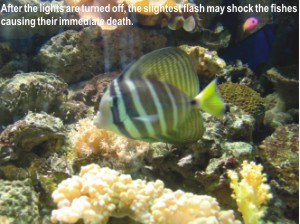|
Hobbies
The
Ocean in a Glass Cage
Imran
H. Khan
 There
is one thing that can be said with certainty about Captain
Tofail Ahmed: He is a man of many talents and passions. By
profession a pilot in Biman for more than two decades, he
is an animation master, miniature ship builder as well as
a musician "in his younger years." Ahmed has always
been fascinated by marine life, and in the mid-nineties, it
led him to do a one-year diploma course in London, on the
"Basic Care of Salt-water fish". The tale only begins
there. There
is one thing that can be said with certainty about Captain
Tofail Ahmed: He is a man of many talents and passions. By
profession a pilot in Biman for more than two decades, he
is an animation master, miniature ship builder as well as
a musician "in his younger years." Ahmed has always
been fascinated by marine life, and in the mid-nineties, it
led him to do a one-year diploma course in London, on the
"Basic Care of Salt-water fish". The tale only begins
there.
Ahmed
is careful to make the distinction between all freshwater
fish, which require little or no expertise to keep, and saltwater
fish, which is usually more expensive and requires more know-how
to keep alive for a long time.
One has
to understand that these fish are not cultivated in just any
place. Maybe a week back, they were swimming around the vast
ocean. The stress of capture and transportation can harm the
sensitive biological processes of the animal.
 Ahmed
has four aquariums and is in the process of building another
one. The last one he built was different: it is a quarantine
tank (also known as a Doctor's Aquarium) for fish that gets
sick and need special attention. Ahmed
has four aquariums and is in the process of building another
one. The last one he built was different: it is a quarantine
tank (also known as a Doctor's Aquarium) for fish that gets
sick and need special attention.
The first
thing that must be done is to make the aquarium bacteria-friendly,
so that the tank can sustain life. The bacteria has to be
created under the surface of the aquarium bed and this process
can take a long time, even up to eight months. For the base
of the aquarium, Ahmed gets rocks mostly from Katabon but
has, on occasion, ventured as far as Saint Martin's Island
for corals.
His fascination
for corals has led him to create something similar to a Reef
Tank in one of the aquariums. There are numerous corals there
that are alive and moving during the day and become stone
cold at night, while other species are alive during the night,
but are just plane coloured rocks during the day. His prize
collection is a Fan Coral (also called Elephant Ear). To give
it the respect it deserves he has kept it in a separate tank.
His aquariums are vibrant with live corals and coral reefs,
all providing curious dwellings for his colourful assortment
of sea life.
 Most
of the marine life in Ahmed's aquariums are either from Singapore
or Bangkok. His collection includes about ten distinct categories
of aquatic beings including an impressive collection of Discus,
Animos, Dwarf, Lion, and even a Clown fish (yes, his own Nemo!) Most
of the marine life in Ahmed's aquariums are either from Singapore
or Bangkok. His collection includes about ten distinct categories
of aquatic beings including an impressive collection of Discus,
Animos, Dwarf, Lion, and even a Clown fish (yes, his own Nemo!)
The Clown
fish is especially interesting. It is a small, brightly coloured
marine fish and is also known as anemone fish, or clown anemone.
It belongs to the species Amphiprion percula and the genus
Amphiprion. An eye catching fish with vibrant colours, a percula
has a bright orange body with three white vertical bars: one
just behind the eye; one in the middle; and the last one (the
posterior bar) near the caudal fin. In nature this fish can
grow to 110 mm in length. Clowns, in general, are very territorial,
but are not otherwise aggressive except to other clowns. Though
in the wild the longest known life-span is an average of 6-10
years, in captivity they may live as long as 18 years. A percula
forms symbiotic relationships with sea anemones (thus the
name) which it uses both as shelter and protection from predators.
In nature the fish and anemone pair generally occurs on coral
reefs. In captivity, they do fine without the anemone, which
is good, since anemones are much more difficult to keep. However,
in order to keep the smile on his 'Clowns', Ahmed also has
a good collection of anemone.
 One
unique fish is the Boxfish with its smooth texture and vibrant
colours. It looks a little gloomy compared to the Clown but
nonetheless, its cuddly dimensions makes it a prize collection
in any aquarium. One
unique fish is the Boxfish with its smooth texture and vibrant
colours. It looks a little gloomy compared to the Clown but
nonetheless, its cuddly dimensions makes it a prize collection
in any aquarium.
The Lionfish
is a fairly aggressive fish whose venom is deadly. "Its
bite will cause you to become sick and as yet, there is no
cure for its bite in Bangladesh" says Ahmed. At most
two Lionfish will co-exist in one tank. Ahmed, being a man
of peace, has played it safe and has only one.
What about
sanitation? When you have pets, you need to look after them.
"I have a Cleaner Shrimp (Lysmata amboinensis) in one
of the aquariums," was the immediate response, "Whenever
a fish is ill or damages its scales, it goes to the shrimp.
This invertebrate creature then cleans the fish of its illness.
So basically, the whole environment is autarkic in nature.
Most shrimps are scavengers and don't necessarily need to
be fed overtly--they usually eat food dropped by other fish."
Hats off to such helpful, undemanding creatures!
 The
type of fish one has, dictates to some extent the setting
up and maintenance of the aquarium. The exciting part is that
one has to totally recreate an artificial environment for
the fish and corals to live in. The slightest variation kills
them. "I make the aquariums, myself and first have to
get the aquariums ready, making a bacteria contaminated area
explains Ahmed. Once this is done and the bacteria have started
to reproduce (thereby creating an artificial and self-sustained
container) I am able to put in the fish. This process can
take more than half a year." The
type of fish one has, dictates to some extent the setting
up and maintenance of the aquarium. The exciting part is that
one has to totally recreate an artificial environment for
the fish and corals to live in. The slightest variation kills
them. "I make the aquariums, myself and first have to
get the aquariums ready, making a bacteria contaminated area
explains Ahmed. Once this is done and the bacteria have started
to reproduce (thereby creating an artificial and self-sustained
container) I am able to put in the fish. This process can
take more than half a year."
"One
thing I have learnt over the years is that you have to know
your water chemistry," says Ahmed. Since the living atmosphere
has to be recreated, you have to know about all the things
that occur in the tanks. "I even have to recreate the
lighting system in the aquariums." Ahmed has a totally
computerised system installed for his little marine friends.
There is a lighting system that turns on a 20 to 30 watt tube
at dawn, and the intensity of the bulb increases throughout
the day (as it does in reality). In the afternoon, the temperature
of the bulbs is the most intense at 75 watt. By evening, another
lighting takes over and the intensity decreases and at 10
pm at night, it's lights out for this mini aquatic world.
The whole system is automatic and is attached to a UPS system
such that the ecology of the ocean lives are not affected
by local load-shedding.  Most
people who collect salt-water fish are from colder countries
and hence, they have to have heating system installed in their
aquariums. Contradictory to this, Ahmed has a chiller, which
always keeps the temperature of the aquariums at 26-degree
Celsius. Most
people who collect salt-water fish are from colder countries
and hence, they have to have heating system installed in their
aquariums. Contradictory to this, Ahmed has a chiller, which
always keeps the temperature of the aquariums at 26-degree
Celsius.
There
are also UV lights installed in the tanks to kill the harmful
or excess bacteria and a calcium reactor with a dosing pump.
Though it is a very crude contraption, it provides the fish
with calcium dosage that is vital for a healthy fish. Ahmed
also has to ensure that there is no metal in the apparatus
he uses, since the saltwater would cause corrosion and this
would be dangerous for the health of the living things in
the aquarium.
Most marine
fish are collected in the wild rather than raised in captivity,
so think twice before you venture in Tofail Ahmed's bold footsteps.
Always do your homework before messing with Mother Nature
and remember your mistakes impact the world's oceans!
Copyright
(R) thedailystar.net 2004
| 